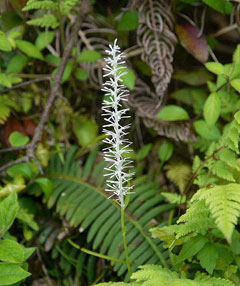Chionographis
Chionographis japonica
Chionographis is a genus of plants that belongs to the family of the Germer family ( Melanthiaceae ). The five species are common in Asia.
- 4.1 Notes and references
Description
Appearance and leaves
Chionographis species grow as an evergreen perennial herbaceous plants. This hemicryptophytes form as outlasting underground, short, stout rhizomes. All plant parts are bare.
The arranged in a basal rosette leaves are divided into petiole and leaf blade. The simple leaf blades are spatulate to ellipitisch. The leaf margins are wavy smooth or tiny. There is Parallelnervatur.
Inflorescences and flowers
Depending on the type is Andropolygamie, sometimes Gynodiözie, rarely Androdiözie before or mostly all flowers are hermaphrodite. Terminally on a more or less long, erect, unbranched Blütenstandsschäften having 3 to 30 small, bract -like leaves are simple, eared inflorescences containing many flowers. There are no support and cover sheets available.
The sedentary, relatively small, mostly zygomorphic flowers are unisexual and threefold or hermaphrodite. The six free bracts are clearly unequal. The top three or four bracts are spatulate - linear to filiform, and the lower two or three are much shorter or absent. There are two circles, each with three stamens present. The inserted at the base of the bloom, with each free stamens are very short. The basifixen dust bags are almost - cordate - ovate to almost round and face outwards. Three Upper constant carpels are fused into a spherical, dreikammerigen ovary. Each ovary chamber contains two ovules. The three free, durable stylus own on top of scar tissue.
Fruit and seeds
Are formed capsule fruits. The spindle- shaped seeds have a wing at one end.
Chromosome numbers
Chionographis species have holozentrische chromosomes. The chromosome numbers be at Chionographis japonica and Chionographis koidzumiana var koidzumiana 2n = 24, in Chionographis koidzumiana var kurohimensis 2n = 44 and 2n = 42 Chionographis hisauchiana
Systematics and distribution
The genus Chionographis in 1867 set up by Karl Johann Maximowicz in Bulletin de l' Academie Imperiale des Sciences de St. Petersbourg, vol 11, p 435. Type species is Chionographis japonica ( Willd. ) Maxim Maxim .. Chionographis. nom. cons. was according to the rules of the ICBN ( Vienna ICBN Art 14.4 & App. III) conserved over Siraitos Raf. nom. rej, the 1836 in Constantine S. Rafinesque - Schmaltz: . was published Flora Telluriana 4, p 26. The genus name is derived Chionographis from the Greek words for snow chion and graphis for brush off; this refers to the inflorescence and the bloom (see photo).
The genus belongs to the tribe Chionographis Chionographideae within the family Melanthiaceae. The Tribe Chionographideae Nakai had earlier also the rank of a family Chionographidaceae ( Nakai ) Takht. or is classified in the family Liliaceae.
The genus Chionographis comes in China (two species), Korea ( sort of) and Japan ( three species).
There are about five Chionographis types:
- Chionographis chinensis K.Krause, Syn: Chionographis merrilliana H.Hara, Siraitos chinensis ( K.Krause ) FTWang & T.Tang. Thrives in shady and moist places on slopes at altitudes 0-700 meters in the Chinese provinces Fujian, Guangdong, Hunan and northeastern Guangxi.
- Chionographis hisauchiana ( Okuyama ) N.Tanaka: It comes with three subspecies in Japan.
- Chionographis japonica ( Willd. ) Maxim. It occurs in Japan and on the Korean Hallaisan Mt.
- Chionographis koidzumiana Ohwi: It comes with two varieties available in Japan.
- Chionographis shiwandashanensis Y.Feng Huang & RHJiang: This endemic species was first described in 2011 and only comes Shiwandashan ago in southern Guangxi. In this way, the flowers are radial symmetry.
Use
From Chionographis japonica young aboveground vegetative plant parts are eaten.
Swell
- Chen Xinqi (陈心启) & Minoru N. Tamura: Chionographis, pp. 88 - text Registered as printed work, In: Wu Zheng -yi and Peter H. Raven (eds.): Flora of China, Volume 24 - Flagellariaceae through Marantaceae, Science Press and Missouri Botanical Garden Press, Beijing and St. Louis, 2000. ISBN 0-915279-83-5 (sections reporting and dissemination )







